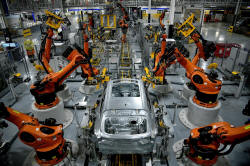Solid U.S. factory orders, business spending on equipment point to
enduring manufacturing strength
 Send a link to a friend
Send a link to a friend
[August 04, 2021] By
Lucia Mutikani
 WASHINGTON (Reuters) - New orders for
U.S.-made goods increased more than expected in June, while business
spending on equipment was solid, pointing to sustained strength in
manufacturing even as spending is shifting away from goods to services. WASHINGTON (Reuters) - New orders for
U.S.-made goods increased more than expected in June, while business
spending on equipment was solid, pointing to sustained strength in
manufacturing even as spending is shifting away from goods to services.
The Commerce Department said on Tuesday that factory orders rose 1.5% in
June after advancing 2.3% in May. Economists polled by Reuters had
forecast factory orders increasing 1.0%.
Orders soared 18.4% on a year-on-year basis. Demand pivoted towards
goods during the COVID-19 pandemic as millions of Americans were cooped
up at home, boosting manufacturing, which accounts for 11.9% of the U.S.
economy. But the surge in demand is straining the supply chain.
"We expect a solid growth path for the factory data through 2021, capped
by capacity constraints and supply chain problems," said Mike Englund,
chief economist at Action Economics in Boulder, Colorado.
The Institute for Supply Management reported on Monday that
manufacturing activity grew at a slower pace in July for the second
straight month as raw material shortages persisted. The survey, however,
suggested that supply chain bottlenecks were starting to ease.
Spending is rotating back to services as nearly half of the population
has been fully vaccinated against COVID-19, allowing people to travel,
frequent restaurants, visit casinos and attend sporting events among
services-related activities that were curbed early in the pandemic.

(GRAPHIC: Factory orders -
https://graphics.reuters.com/USA-STOCKS/zjpqkqmeepx/
factoryorders.png)
BROAD GAINS
The increase in factory goods orders in June was broad, with notable
gains in machinery, computers and electronic products, as well as
electrical equipment, appliances and components.
Orders for transportation equipment increased 2.0%, boosted by a surge
in bookings at Boeing. But motor vehicle orders fell 0.3%. Auto
production is being hampered by a global shortage of semiconductors.
[to top of second column] |

Autonomous robots
assemble an X model SUV at the BMW manufacturing facility in Greer,
South Carolina, U.S. November 4, 2019. REUTERS/Charles Mostoller

Though momentum is slowing, manufacturing will likely continue to expand.
Unfilled orders at factories increased 1.0% in June. Shipments advanced 1.6%.
The unfilled orders-to-shipments ratio fell to 6.94 from 6.96 in May.
Inventories climbed 1.0% after increasing 1.1% in May. The
inventories-to-shipments ratio slipped to 1.48 from 1.49 in May.
The increase in factory inventories in June was bigger than what the government
assumed in its advance estimate for second-quarter gross domestic product
published last week.

The Commerce Department's Bureau of Economic Analysis estimated that GDP grew at
a 6.5% annualized rate last quarter, picking up from the first quarter's 6.3%
pace. That hoisted the level of GDP well above its peak in the fourth quarter of
2019.
Economists anticipated that GDP growth could be raised to as high as a 6.7% rate
when the government publishes its revision later this month.
"It now looks like the BEA data will need to be revised up," said Daniel Silver,
an economist at JPMorgan in New York. "We continue to expect inventories to
boost GDP growth significantly in third quarter following the big pullback
reported through the second quarter. We also think equipment spending will
continue to increase at a solid rate in the third quarter."
The Commerce Department also reported that orders for non-defense capital goods,
excluding aircraft, which are seen as a measure of business spending plans on
equipment, rose a solid 0.7% in June instead of 0.5% as reported last month.
(GRAPHIC: Core capital goods - https://graphics.reuters.com/USA-STOCKS/klpykelzkpg/corecap.png)
Shipments of core capital goods, which are used to calculate business equipment
spending in the gross domestic product report, advanced 0.6% as estimated last
month. Business spending on equipment was robust in the second quarter, notching
the fourth straight quarter of double-digit growth.
(Reporting By Lucia Mutikani; Editing by Andrea Ricci)
[© 2021 Thomson Reuters. All rights
reserved.] Copyright 2021 Reuters. All rights reserved. This material may not be published,
broadcast, rewritten or redistributed.
Thompson Reuters is solely responsible for this content. |